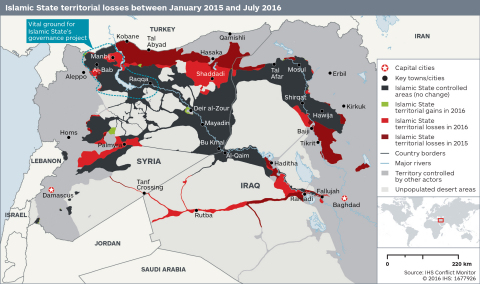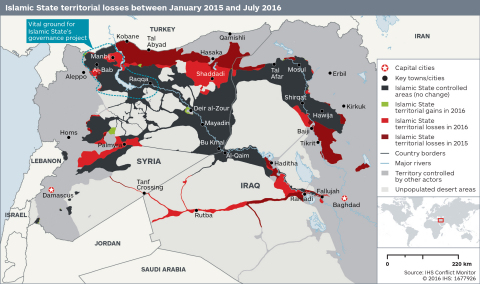LONDON--(BUSINESS WIRE)--Territory controlled by the Islamic State shrunk by 12 percent in the first six months of 2016, according to new analysis released today by IHS Inc. (NYSE: IHS), the leading global source of critical information and insight.
In 2015, the Islamic State’s caliphate shrunk by 12,800 km2 to 78,000 km2, a net loss of 14 percent. In the first six months of 2016, that territory shrunk again by 12 percent. As of 4 July 2016, the Islamic State controls roughly 68,300 km2 in Iraq and Syria, which is roughly the size of Ireland or the US state of West Virginia.
“Over the past 18 months, the Islamic State has continued to lose territory at an increasing rate,” said Columb Strack, senior analyst at IHS and lead analyst for the IHS Conflict Monitor. “As the Islamic State’s caliphate shrinks and it becomes increasingly clear that its governance project is failing, the group is re-prioritizing insurgency. As a result, we unfortunately expect an increase in mass casualty attacks and sabotage of economic infrastructure, across Iraq and Syria, and further afield, including Europe.”
In April 2016, the IHS Conflict Monitor team outlined the decline in primary revenue sources for the Islamic State. In mid-2015, the Islamic State’s overall monthly revenue was around $80 million. As of March 2016, the Islamic State’s monthly revenue dropped to $56 million. “This figure has probably continued to decrease since March by at least another 35%,” said Ludovico Carlino, senior analyst at IHS. “Combined with the military setbacks on the ground, this is having an impact on the internal cohesion of the group as indicated by a marked increase in defections and desertions since January 2016.”
What’s next for the Islamic State?
“Over the coming year we are likely to see more towns and cities become isolated from the core caliphate, as was the case in Ramadi and Fallujah,” Strack said. “This could enable the fragmentation and gradual defeat of the Islamic State as a conventional force.”
The Islamic State is coming under increasing pressure in northern Syria, an area which IHS considers vital ground for the group, which it cannot afford to lose if its governance project is to survive. This includes Raqqa, the seat of the group’s leadership and a model city for its governance project, and areas giving access to the Turkish border, via the logistics hubs of Manbij and al-Bab.
“The likely capture of Manbij by the US-backed Syrian Democratic Forces (SDF) would have a major impact on the Islamic State's ability to supply Raqqa, and by extension the remainder of its territory, with new recruits and supplies, undermining its ability to govern,” Strack said. “The Turkish border is the only viable entry and exit point for the caliphate, and reduced access since the loss of Tal Abyad in June 2015 has contributed to increasing pressure on the Islamic State’s ability to fund itself.”
It is this governance project that allows the Islamic State to claim that other jihadist groups need to submit to its authority. As the project fails, the Islamic State becomes more likely to cooperate with other jihadist groups.
Changes spotted in messaging
“For groups like the Islamic State, the battle for hearts and minds is just as important, if not more important, than the military confrontation. As such, the expansion of terrorist attacks outside the core caliphate helps the group claim that it is still gaining support and expanding its influence, despite setbacks in Iraq and Syria,” said Firas Abi-Ali, senior principal analyst at IHS. “The Islamic State’s messaging has therefore adjusted to the caliphate’s loss of territory by pointing to its expansion outside Iraq and Syria, and to Allah’s assurance of final victory.”
About IHS (www.ihs.com)
IHS (NYSE: IHS) is the leading source of insight, analytics and expertise in critical areas that shape today’s business landscape. Businesses and governments in more than 150 countries around the globe rely on the comprehensive content, expert independent analysis and flexible delivery methods of IHS to make high-impact decisions and develop strategies with speed and confidence. IHS has been in business since 1959 and became a publicly traded company on the New York Stock Exchange in 2005. Headquartered in Englewood, Colorado, USA, IHS is committed to sustainable, profitable growth and employs about 8,800 people in 32 countries around the world.
IHS is a registered trademark of IHS Inc. All other company and product names may be trademarks of their respective owners. © 2015 IHS Inc. All rights reserved.
About the IHS Conflict Monitor
The IHS Conflict Monitor is an open-source intelligence collection and analysis service, which includes unrivalled data coverage of the conflict in Iraq and Syria, weekly control maps, as well as in-depth quantitative and qualitative analysis by IHS Jane’s security experts.
To learn more and for a free trial please visit https://www.ihs.com/Info/0216/conflict-monitor.html.




